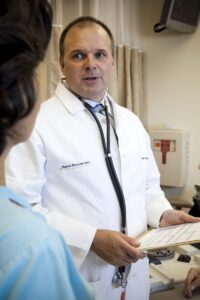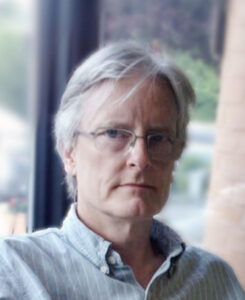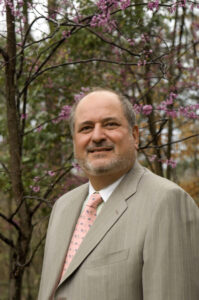Each Spring, Emory’s Office of Technology Transfer hosts an Annual Celebration of Technology and Innovation. Though we weren’t able to gather in person to celebrate this year, we are extremely proud of the 2021 awardees. We took time to interview several of this year’s awardees to learn more about their technologies and their reaction to winning an award!
2021 Innovation of the Year – Serological Test for SARS-CoV-2; John Roback, MD, Ph.D.
Can you introduce yourself?
“John D. Roback, MD PhD. I am a Professor of Pathology and Laboratory Medicine, Medical Director of Emory Medical Laboratories, and Executive Vice-Chair for Clinical Operations in the Department of Pathology and Laboratory Medicine.”
What did you enjoy about winning an award?
“It is a wonderful recognition of a team science initiative to rapidly implement SARS-CoV-2 serology testing in Emory Medical Laboratories at the start of the pandemic. The short time from test development in the research laboratory (Drs. Wrammert, Suthar, and Ahmed) to validation, FDA authorization, and clinical implementation was a testament to the collegial team work between this group and their colleagues during the process.”
Can you tell us a little bit more about the technology that you received the award for?
“The team led by Drs. Wrammert, Suthar, and Ahmed began developing a COVID-19 serology assay (a test to detect antibodies against the SARS-CoV-2 virus) early in 2020. The test was transitioned to Emory Medical Laboratories where I led a team that produced the clinical data resulting in FDA Emergency Use Authorization and subsequent clinical use of this test to identify patients who were exposed to the virus and/or vaccinated.”
What does this award mean for your lab or your family?
“From my perspective, the leadership and staff of Emory Medical Laboratories was very proud to have made such an important clinical impact early in the course of the pandemic through the implementation of this serology assay.”
What are the next steps for this technology?
“We are continuing to offer it in Emory Medical Laboratories to positively impact patient care.”
2021 Deal of the Year – Phaeno, Inc. – A Method for Full-Length RNA Deep Sequencing with Existing Next-Generation Technology; William Agnew, Ph.D. & Mark Emerick, Ph.D.
Can you please introduce yourselves?
Dr. Agnew: “My name is William Agnew. I have come from academia – I was trained in UCLA at the Molecular Biology Institute and was on the faculty of Yale for a number of years in the Medical School in the department of cell and molecular physiology. Then I moved to Johns Hopkins University, where I was the Chair of Physiology for about 13 years, as well as a professor of physiology and neuroscience. Around 2009, I stepped down from the chairmanship and went on as a visiting professor at Emory to pursue to development of a new technology. My background is in molecular neurobiology, which led us into a very interesting area which resulted in us developing the technology that represents the intellectual property that we’ve licensed from Emory and Johns Hopkins.”
Dr. Emerick: “I’m Mark Emerick. I have been at Emory for a long time. I have a PhD from Yale in Physiology and Molecular neuroscience and a postdoc at Hopkins. I hooked up with Bill in the early 2000s and we were working on a project about ion channel structural diversity and the mechanisms that generate diversity in cells, which led to the project of sequencing the full length of the transcriptome of cells, and then moved to Emory and developed this sequencing technology with Bill.”
Can you describe the technology for which you won the award?
Dr. Agnew: “In the past 20 years – this has really been the era of the genome – one of the technical triumphs has been the fact that whereas the first genome took 10 years and close to $3 billion to sequence, we can now sequence an individual’s genome in about 2 hours for a wholesale cost of about $600. The result of having this ability to pull out a patient’s genome is to look at the constellation, the family of genes that that person might have inherited from their parents, plus any mutations that may have accumulated during their development. Every cell has in it a group of molecules that are the molecular machinery of the cell – these are the proteins and they control everything in the cell. All of those properties are dictated specifically by the group of proteins that the cell expresses. There are about 25,000-30,000 of these and they are different for every type of cell, called the proteome. To understand the cause of disease, to diagnose it properly, understand the mechanisms, identify the targets for drugs or other molecular interventions, you need to know the proteome. The idea is that we take a snapshot of the proteome to understand what makes a cancer cell a cancer cell, what makes an Alzheimer’s neuron an Alzheimer’s neuron. That can’t be deduced by sequencing the genome. What we did is we took the technology instruments that are used to sequence a whole genome at a very low cost, and changed the chemistry that is used a little bit so that now we can sequence all of the messages in a cell – and that’s the advance. One of the other big things we are looking at is we need to have national-scale surveillance of whole viral genomes and this technology can do that. We are pretty excited about the prospect, optimizing it so that you can sequence ground water samples from 1,000 communities every two days and spot the emergence of any viruses and you would even be able to do sophisticated analysis to track their migration and development. As hard as it has been to move this forward, and it has been a long process, this is a golden moment to make a contribution to human health and demonstrate the full power of this technology.”
What are the next steps for this technology?
Dr. Agnew: “The basic technology was proven in proof of concept studies. That allowed us to write patents with Emory and Johns Hopkins … Where we are now is we want to demonstrate the technology at full scale, and we are getting to the point where we want to optimize the synthesis of the reagents and steps into what are called deliverables – which are kits of reagents and also the data pipeline so that these can be sold or licensed to a genome center. We hope that around this time next year, we will be able to hand out beta kits so that they can go and exploit this. This could also get surged because of possible applications for COVID. We are well positioned to have a big impact.”
What prompted you to start a biotech company?
Dr. Agnew: “Mark basically invented the core trick that goes into this stuff and we did a huge amount of work inventing the supporting technology and analysis and then we decided – we might want to protect that! We wrote the patents and Emory and Johns Hopkins were really supportive, and it just turned out that it would be best if we formed our own company, took ownership of the rights of the technology and then we could license it to another company to develop or develop some of the core elements and license the products. It would just give us a lot more flexibility to go to a wide variety of people whose problems could potentially be solved with it and make sure that it is disseminated in the best way possible. We also have a bunch of other innovations and we thought if we could generate the revenue, we could put that out for public benefit as well. Forming a company seemed like a good mechanism.”
What does winning this award mean to you personally?
Dr. Agnew: “The amount of support we had, in this kind of competitive environment was spectacular and can never express our gratitude for giving us the freedom to do what we were trying to do and believed in us and there was a time a few years ago when I went to one of these award ceremonies, and I remember the person who got up had won something similar to this, and gave a speech and I thought wow, that is really cool, and maybe someday we will be talking to folks about this. So it’s huge, and Emory and Johns Hopkins have been so supportive. To get recognized for what we have been trying to do, which has been very hard, quite frankly – it has required a lot of tenacity – is another gift from the University. It’s pretty humbling, it’s really cool.”
Dr. Emerick: “I would confirm that. The last 20 years have been rather difficult to get support for what we have been working on. We had a bit of trouble making money, so the funds from people were very helpful, and Emory was certainly very helpful. Just in the past few weeks I have been doing literature reviews, and people have been republishing our results with great fanfare, the results that we had trouble getting published 15-20 years ago. This is the kind of confirmation that shows what we knew at the time that we are on the right track. It’s only now that it is beginning to build traction, and now with this award, it is a great confirmation of that.”
Do you have one word to describe your feeling winning this award?
Dr. Agnew: “I was so surprised – we got this announcement and we’d had a pretty good set of things happen over the course of about a week, and then this announcement came in and it was just the icing on the cake, tremendously exciting. One word would be ‘thrilled.'”
Dr. Emerick: “I was completely unaware. I was completely unprepared for this. It wasn’t on my radar, so when it arrived, I was like ‘That’s really nice!’”
2021 Significant Event of the Year – Aligos Therapeutics, Inc. – Initial Public Offering; Raymond F. Schinazi, Ph.D.
Can you introduce yourself?
“My name is Dr. Raymond F. Schinazi. I am a professor of pediatrics at Emory University. I’ve been at Emory for about 40 years. The focus of my work is HIV, HBV, HCV and emerging viruses. That’s what I do for a living. I am interested in particular in the discovery and development of drugs for these viruses.”
Can you talk about the specific technology that you won the award for?
“Viruses in general are made up of different components, which includes of course the genetic material of the virus, which, in the case of Hepatitis B is DNA. The DNA is protected by something called the capsid. We have been focused on the capsid, because if we can destroy the capsid or alter its shape, we can allow the enzymes in the body to destroy the DNA of the virus. Only viruses have capsids, so you can target the capsid and by doing that, for example, you can open it up and expose it to the elements and it will degrade, because the DNA will no longer be protected. Its shield will be gone. We have been interested in compounds that specifically target the capsid. We call them capsid effectors.
These drugs that we have been working on target very specifically the hepatitis B capsid. The capsid also contains something called cccDNA, a latent form of DNA. By interfering with the cccDNA with capsid effectors, you can basically stop cccDNA from producing new variants or viruses and that is a big advantage. Now, even if you use regular antiviral agents, you can prevent the production of new viruses, but they can come back. You need to tackle the reservoir, which is found in the cccDNA.”
What is the current standard of care for Hepatitis B, and how can this be a game changer?
“The current standard of care is basically taking these drugs forever. They are known to prevent or delay the development of cancer of the liver. The only way to solve that problem is to have a liver transplant, there is no drug that can work. We are trying to eliminate the virus with these capsid effectors in combination with regular antivirals. You can suppress the virus to very low levels and also hit it with the new drugs and tackle the reservoir of the virus so that you don’t have a reactivation. Eventually with time – about a year of treatment – you clear the virus completely. There are markers for that. One of the clinical markers to determine if you have cleared the virus, is that if you stop therapy, the virus doesn’t come up again. That’s called a functional cure. When you have a functional cure, you are cured. You don’t need to take any more drugs, and you stop the process of getting liver cancer completely.”
How did your collaboration with Aligos Therapeutics come about?
“I have known the CEO of the company – his name is Dr. Larry Blatt – for a long time. He is a colleague and friend. [When starting Aligos Therapeutics] he needed assets, and at the time we had discovered this drug but didn’t have any suitors. With Emory’s help, we were able to license this technology to this small biotech company start up in California. Together we came up with an even better compound than the one in the original patent. They developed the compound with us, did all the preclinical work, and decided to put it in people who are not infected with hepatitis B to make sure it is safe and get data on the pharmacokinetics – how long the drug persists in the body. Then they went into infected patients. The results are preliminary and just being provided to the public that at a 100 mg dose – the lowest dose they have used so far – they were able to clear the virus in half the patients after only two weeks of treatment. This doesn’t mean that it has been cleared from the body completely, there was just none in circulation after only two weeks of treatment at a 100 mg once a day, so that’s pretty impressive. You can imagine what would happen after say 4 weeks, or 6 months, or a year. The question is whether they will rebound after you stop therapy. There are many questions to be answered, but at least the preliminary results so far are encouraging. And of course, the work will continue. What we would like to see is a decline in virus and we would also like to see that when you stop therapy, the virus doesn’t pop back up immediately.”
What are the next steps?
“We need to find the best dose that will give the biggest impact safely. That’s what we are aiming for. Safety is paramount, efficacy is second, and long-term effects are also important. And remember, you are clearing a virus that has been there for 20 to 50 years in the body. It is a big challenge, because if one is left, the virus will expand.”
What does this award mean to you?
“OTT works in partnership with people like myself and getting this award is a way to say thank you to the inventors. It’s not just me, my group helped me immensely. And they are really the heroes in my lab. Drs. Sebastien Boucle, Franck Amblard, Leda Bassit. We have people from many nationalities in our lab, and you saw people from diverse background coming together to work for the common good. It is a big deal to be recognized for participating in something that could cure a major disease. It is an amazing opportunity and to be recognized by our university is a good thing. It’s nice to be recognized by peers at your university, and that’s what this award does.”
Is there one word you would use to describe how you feel winning this award?
“Gratitude.”
2021 Significant Event of the Year – Aligos Therapeutics, Inc. – Initial Public Offering; Leda C. Bassit, Ph.D.
Can you introduce yourself?
“I am an Assistant Professor in the department of Pediatrics at Emory University, with 28 years of experience in virology and viral diagnosis working with HIV, hepatitis B and C, West Nile, Dengue, Chikungunya, Yellow fever, Zika viruses, and most recently coronaviruses, including the variants of SARS-CoV-2 strains. My extensive know-how focuses on the studies of antiviral agents against HBV and other relevant viral pathogens, cell culture systems, drug-drug interactions, antiviral drug resistance, toxicities (mitochondrial DNA and glutathione), and neutralization assays using several cell systems (organoid systems), such as primary human hepatocytes or hepatoma cells, kidney (Vero), neuron, fibroblast, myelogenous leukemia, primary human macrophages, pulmonary, colon cells, among others.”
What did you enjoy about winning an award?
“To be able to contribute on the development of a novel antiviral drug that has the potential to cure chronic hepatitis B virus infection which affects ~300 million people worldwide.”
Can you tell us a little bit more about the technology that you received the award for?
“HBV nucleocapsid plays an essential role in the viral replication cycle that includes HBV genome packaging, reverse transcription, intracellular trafficking of relaxed circular DNA (rcDNA) into the nucleus and maintenance of chronic infection. Our drug is a capsid assembly modulator (CAM) with a unique glyoxamidopyrrolo backbone, which has shown substantial in vitro and in vivo effects in HBV DNA replication.”
Is there anything else you would like to share about the experience?
“I am glad to be part of a team that is focused on the development of safer antivirals that target the HBV replication cycle and have the potential to prevent the nearly one million human deaths annually due to liver diseases associated with hepatitis B.”
Can you use one word to describe winning an award?
“Appreciated.”




